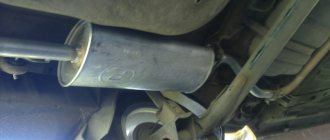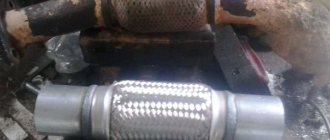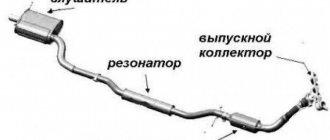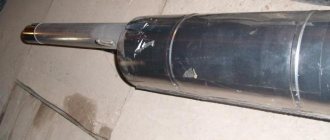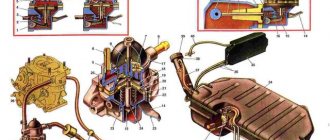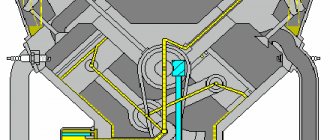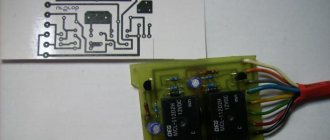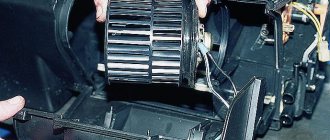Problems with the exhaust system of a VAZ 2107 car are easy to recognize - the noise of the engine is complemented by a roaring sound coming from under the bottom of the car. In 90% of cases, a car enthusiast can solve the problem on his own by replacing or repairing a burnt-out muffler. You just need to understand the exhaust structure, correctly diagnose the malfunction and replace the worn element.
- Design and operation of the exhaust tract
- Problems with the muffler and other elements
- How to change the main muffler
Preparation of tools and workplace
- Replacement procedure
Video: replacing a VAZ 2107 muffler in a garage
- Video: how to seal an exhaust without welding
- Video: making a direct flow with your own hands
- Video: how to remove the resonator VAZ 2101—2107
How the VAZ 2101-2107 exhaust system works and works, repairs and modifications
The exhaust system of a car has a special function - to remove waste gases from the engine. As you know, fuel after combustion leaves gases that must be completely released. The faster and better this process takes place, the higher the efficiency of the power unit. The gases first move in the direction of the exhaust pipe of the VAZ-2107 exhaust system, and then exit through the muffler. A hermetic seal is placed between the exhaust manifold of the internal combustion engine and the exhaust pipe, which prevents leakage of exhaust gas under the hood of the car. In some cases, instead of a gasket, corrugation is used to reduce vibrations. However, installing it is already a matter of tuning, adjusting all other elements of the system to the required parameters.
What's in the exhaust system?
The exhaust of the “seven” consists of several main parts: the exhaust manifold, the exhaust pipe, the resonator and the muffler. In addition, there are additional elements: rubber fasteners, flanges, seals.
The VAZ-2107 exhaust system includes the following elements: 1. exhaust manifold gasket; 2. exhaust pipe (pants); 3. bracket for fastening to the gearbox; 4. clamps for connecting pipes; 5. front resonator (first additional muffler); 6. rear resonator (second additional muffler); 7. main muffler; 8. Rubber suspension mount or cushion.
Exhaust system VAZ-classic
Let's take a closer look at the main parts of the exhaust system.
Exhaust manifold , made of good quality metal (sometimes replaced by tuners with steel.) This part of the exhaust system with the function of collecting exhaust gases. It is a unit of several cylinders or tubes. It is made on VAZ-2107 from cast iron. One side is attached to the exhaust pipe, the other to the engine. During operation of the machine, the exhaust manifold is subjected to heavy loads, since due to its design features it operates in extreme conditions. Gases tend to heat up to a temperature of a thousand degrees, and after stopping the engine, they cool sharply, which inevitably leads to the formation of condensation. Corrosion appears on the collector. Thus, the exhaust manifold is responsible for: • removing exhaust gases from the engine chambers; • for filling and purging the chambers.
The operation of the exhaust manifold is inextricably linked with resonance. During the operation of the engine - the combustion of the fuel-air mixture - strong pressure is generated, which is used to circulate gases. The pressure or pressure wave flows back into the cylinders, thereby helping the next portion of gases escape. The higher the engine speed, the more pressure is created and the faster the exhaust gases escape.
Downpipe
“Pants” - this name was given to this part for the characteristic shape of the exhaust pipe receiving gases coming from the engine exhaust manifold. The exhaust pipe is also an integral part of the exhaust system. It is located after the exhaust manifold, in front of the resonator. Made from durable metal, tuned models include corrugated parts. The receiving pipe of injection machines is different.
The exhaust pipe of the exhaust system is “pants”, this one is for carburetor cars
The “pants” on the VAZ-2107 quite often fail. This occurs mainly due to environmental influences. The same condensate formed as a result of temperature fluctuations negatively affects the metal components of the pipe. In addition, in winter in Russia, roads are sprinkled with compounds containing salts and various chemicals. They also have a bad effect on the exhaust pipe body. On the VAZ-2107, trousers are made from ferrous metal at the factory. However, you can independently replace the model with modernized analogues.
-The best choice is a receiving pipe made of stainless steel. It is, however, expensive. But there are a lot of advantages: resistance to corrosion and long service life. -Aluminized version of the pants. It is made of ordinary steel, but coated with aluminum. The service life of such products is more than five years (a standard pipe can burn out after two years). Additionally, they can be equipped with corrugated spacers.
The intake pipe for the injection VAZ-2107 has differences
Resonator device
A resonator or additional noise-absorbing element between the exhaust pipe and the muffler - in it the noise encounters its first obstacle. For the VAZ-2107 injection engine, it must comply with Euro-3 standards and have a built-in catalytic converter.
Resonators for injection VAZ-2107: the upper one with a catalyst, and the lower one with a “blende” instead of it
The resonator is the middle part of the exhaust system, which is a cylinder-shaped iron container. Its main task is to reduce exhaust noise at the preliminary stage. 40 mm connecting pipes are hermetically welded to it: • the front one is equipped with a return flange for pants; • rear pipe - has two places for connecting to the muffler. The resonator pipes of carburetor “sevens” can be equipped with one or two tanks. This depends on the engine modification: 1 tank is installed on 1.3-liter versions, 2 tanks on versions with 1.5 and 1.6 liter engines.
The VAZ-2107 resonator consists of several parts. 1. Cylinder housing. It is hermetically sealed. 2. Inner tube. It includes many perforations for the passage of exhaust gases. 3. Transverse septum. Used as a separator for resonator chambers. In essence, the resonator performs many useful functions, although it is considered an additional exhaust element.
Let's take a closer look at what it does. 1. Reduces the noise level of exhaust gases at the stage of entry into the muffler. 2. Does not create any resistance to exhaust energy. 3. Cools the hot gas coming from the engine. 4. Accepts part of the load that would go to the main muffler, thereby extending the life of the latter. The resonator on the injection VAZ-2107 of the latest years of production (compliance with Euro 2/3 standards) is supplemented with a catalyst. This is a special neutralizer installed between the pants and the resonator pipe. Such a resonator has a flange connection with the exhaust pipe, a different bend and is not suitable for carburetor “sevens”. During operation, it heats up to high temperatures, which is why it was taken down from the body and a heat shield was installed. Several versions of resonators can be installed on the VAZ-2107. Large resonators were installed on the old classic “sevens” with a carburetor.
Resonator for carburetor VAZ-2107
Muffler device
Silencer that absorbs most of the sounds. A regular stock VAZ-2107 muffler must be of high quality in order to effectively reduce noise. The last, outlet part of the exhaust system. The main function is to reduce noise by influencing sound vibrations. The muffler is equipped with special cameras that “catch” sounds of different frequencies. Getting inside such chambers, the sound gives up its energy, as if entangled in a labyrinth, and turns into heat. This is why the muffler parts are so hot when the car is running. But the functions of the muffler are not limited to this. It can be called the “last resort” of the exhaust system, because it is here that the exhaust gases find an outlet, and the engine cylinders are ventilated and cleaned.
It is important to understand that the muffler takes on very high thermal and chemical loads, so it can burn out over time. Impacts from crushed stones from the road, salt, moisture and other reasons also contribute to wear of the part. The muffler is often changed by owners who use their “Seven” in the winter season.
What muffler can be installed on the “seven”
There are 4 options for replacement:
- Standard VAZ 2101-2107 muffler made of ordinary steel with anti-corrosion coating. The plus is the low price of the product, the minus is the unpredictable duration of work. When purchasing, it is quite difficult to evaluate the quality of the metal and workmanship, unless the welds are made completely carelessly.
- Factory section made of stainless steel. The option is not cheap, but durable. The main thing is not to buy a fake made from cheap Chinese metal.
- The so-called direct-flow sports muffler, manufactured in a factory.
- Weld the outlet element of the desired design yourself.
If you do not have welding skills, the fourth option is automatically eliminated. All that remains is to choose between stock and sports parts.
A straight-through muffler differs from a standard muffler in the following ways:
- shape - round, outlet of larger diameter;
- design - inside is a straight perforated pipe, lined with fireproof sound-absorbing material;
- the operating sound is low-frequency, louder.
The forward flow resistance is significantly less than the factory model of the muffler. The design makes it possible to ventilate the cylinders more efficiently and increase engine power by up to 5 hp. With. A side effect is a higher noise level, which brings pleasure to fans of extreme driving.
The stock design muffles noise due to several internal partitions and additional perforated pipes, causing gases to change direction and be reflected repeatedly from obstacles. Hence the high resistance of the element and a small drop in power.
It is not difficult for a car enthusiast who owns a welding machine to make a forward flow independently:
- Make a round tank from sheet metal (you will need rollers) or select a ready-made can from another car brand, for example, Tavria.
- Place a perforated pipe inside, having previously drilled many holes with a diameter of 5-6 mm.
You can refine the outlet pipe using a nickel-plated decorative nozzle. The choice of products in size and shape is extremely wide, the prices are quite affordable.
DEVICE AND PURPOSE OF THE VAZ 2107 RESONATOR
The resonator is a cylindrical metal tank designed to preliminary reduce exhaust sound. Connecting pipes with a diameter of 40 mm are hermetically welded to it at the front and rear. The front pipe is equipped with a mating flange for the catalyst or exhaust pipe, and the rear pipe has two longitudinal slots for docking with the muffler section.
Resonator pipes for carburetor models VAZ 2106-2107 are equipped with one or two tanks. The first type was installed on cars with an engine displacement of up to 1.3 liters, the second - on modifications with more powerful engines of 1.5-1.6 liters.
The resonator consists of:
Sound vibrations in the resonator are damped due to the reflection of waves from the partition and walls of the housing
The operating principle of the resonator is based on the phenomenon of sound resonance. Getting inside the housing along with the exhaust gases, sound waves penetrate through the perforations in the pipe and are repeatedly reflected from the outer walls of the tank. Mutual damping of oscillations occurs, and the amplitude of the waves decreases. As a result, the volume of the exhaust sound is significantly reduced.
The VAZ 2107 resonator performs the following functions:
Exhaust gas system: 1 - gasket; 2 — exhaust pipe of mufflers; 3 — bracket for fastening the exhaust pipe; 4 - clamps; 5 — additional muffler; 6 — main muffler; 7 — cushion for mounting the exhaust pipe of mufflers
What muffler can be installed on the “seven”
There are 4 options for replacement:
- Standard VAZ 2101-2107 muffler made of ordinary steel with anti-corrosion coating. The plus is the low price of the product, the minus is the unpredictable duration of work. When purchasing, it is quite difficult to evaluate the quality of the metal and workmanship, unless the welds are made completely carelessly.
- Factory section made of stainless steel. The option is not cheap, but durable. The main thing is not to buy a fake made from cheap Chinese metal.
- The so-called direct-flow sports muffler, manufactured in a factory.
- Weld the outlet element of the desired design yourself.
Standard mufflers are made of ordinary metal with an anti-corrosion coating.
If you do not have welding skills, the fourth option is automatically eliminated. All that remains is to choose between stock and sports parts.
A straight-through muffler differs from a standard muffler in the following ways:
- shape - round, outlet of larger diameter;
- design - inside is a straight perforated pipe, lined with fireproof sound-absorbing material;
- the operating sound is low-frequency, louder.
The factory-made forward flow is painted on the outside with heat-resistant paint, the pipe outlet is equipped with a decorative nozzle.
The resistance of the forward flow is significantly less than that of the factory model of the muffler. The design makes it possible to ventilate the cylinders more efficiently and increase engine power by up to 5 hp. With. A side effect is a higher noise level, which brings pleasure to fans of extreme driving.
The stock design muffles noise due to several internal partitions and additional perforated pipes, causing gases to change direction and be reflected repeatedly from obstacles. Hence the high resistance of the element and a small drop in power.
VAZ 2107 replacement of mufflers yourself
In a conventional element, sound and gases change the direction of movement several times; in a direct flow, they are dissipated through the perforation of the pipe
It is not difficult for a car enthusiast who owns a welding machine to make a forward flow independently:
- Make a round tank from sheet metal (you will need rollers) or select a ready-made can from another car brand, for example, Tavria.
- Place a perforated pipe inside, having previously drilled many holes with a diameter of 5-6 mm.
It's easier to make slits in a pipe, but it's better to spend more time making the holes - Fill the cavity between the straight channel and the walls tightly with non-flammable basalt fiber.
- Weld the end walls and supply pipes.
A curved element from an old muffler is perfect as an inlet pipe. If desired, the direct flow can be made double - then the noise level will decrease - At the required points, attach 3 fasteners corresponding to the standard hangers.
You can refine the outlet pipe using a nickel-plated decorative nozzle. The choice of products in size and shape is extremely wide, the prices are quite affordable.
LOCATION OF THE RESONATOR VAZ 2107
The exhaust system of carburetor VAZ 2107 consists of three sections:
A similar system was installed on the first seven with an injector that complied with Euro 0 standards. Later, injection modifications of the VAZ 2107 appeared, produced in accordance with the requirements of Euro 2 and Euro 3, in which the exhaust tract was supplemented with a fourth section - a catalytic converter located between the exhaust and resonator pipes .
VAZ 2107 injection models that meet Euro 2 and Euro 3 environmental requirements were equipped with a catalytic converter
The resonator, connected at the front to the exhaust pipe or catalyst, starts under the gearbox and ends in front of the rear axle beam. The resonator tank is located to the right (in the direction of travel) of the propeller shaft. The connecting pipe coming out of the body is bent upward and docked with the main muffler pipe that goes around the rear axle. The entire structure is supported by the engine exhaust manifold flange, a metal bracket and rubber hangers attached to the bottom of the car.
Some breakdowns
The exhaust system of the VAZ 2107, the price of which can be impressive, does not always provide for the need to contact a car service if a breakdown occurs with it. There are malfunctions of the muffler itself, the exhaust manifold, corrugations, and neutralizer. The muffler most often fails due to low-quality gasoline and mechanical failures. On average, this unit lasts about three years. Here we can advise you to refuel only at proven gas stations, and be careful when driving over obstacles in nature. When replacing, buy a quality product.
A VAZ 2107 exhaust system diagram may be needed if you intend to make repairs. Many questions arise when the neutralizer fails. The replacement just costs a pretty penny. Many car owners simply throw it away. Even then, some work needs to be done. There is a way out of this situation. In place of the standard neutralizer, you can install parts from another manufacturer. They are much cheaper and have good quality. The main thing is to first find out what reviews there are about this part. This is not a problem when purchasing. Both the seller and other buyers will advise.
The exhaust system of the VAZ 2114, the price of which is 500 rubles, may require the installation of a flame arrester. One feature must be taken into account here. Not every flash arrester will fit your vehicle. You will have to look for one that is suitable for your brand. The metal catalyst is mostly praised. According to reviews, such failures are much less common.
MANUFACTURERS OF RESONATORS FOR VAZ 2107
In the post-Soviet space you can purchase resonators from many manufacturers. The production devices in greatest demand are:
There are no big differences between the products of these brands. The service life of resonators made of refractory steel is approximately the same and amounts to 20-30 thousand kilometers. The service life of stainless steel products is approximately twice as long, but the price is one and a half times higher than the price of analogues made of ferrous metal.
Stainless steel resonators last much longer than conventional ones, but they also cost significantly more.
MALFUNCTIONS AND REPAIR OF THE RESONATOR
Resonator malfunctions include:
An annoying knock coming from under the car's bottom is usually the result of a loose exhaust pipe beating against the body and other components. The reason for this is the rubber fasteners, which wear out and stretch over time and cannot provide rigid fixation of the exhaust tract when moving. The problem is solved by replacing these fasteners.
Black soot indicates burnout of the resonator tank
Typically, exhaust tract hangers last much less than the pipe itself. Check the condition of the rubber bands at intervals of 10 thousand km; if cracks are found, immediately install new suspension mounts.
Other problems can be resolved in the following ways:
If there is a slight burnout, you can try welding the resonator tank directly on the car
Car enthusiasts with experience in welding can make a resonator tank with their own hands. To do this you should:
VIDEO: MALFUNCTIONS IN THE EXHAUST SYSTEM OF CLASSIC VAZ MODELS
Threaded connection
White smoke from the exhaust pipe
The old spare part is still cut off with a grinder. In order to install a new part, you must do the following:
- On the rings and exhaust pipe, drill eight holes with a diameter of 4-6 mm around the circumference at the points of contact;
- Using an M5 tap, cut threads in the drilled holes;
- Treat all structural parts with sealant;
- Screw the bolts into the holes;
- Install corrugation.
The use of high-temperature sealant will ensure the reliability of the connection. After completing these steps, you will receive a fairly high-quality and sealed car exhaust system assembly.
Replacement of resonator VAZ-2107i injector
Hello everyone, back in the winter on New Year’s Eve the resonator burned out, it was 4 years old, it was inherited from the previous owner, I changed the main muffler about a year and a half ago. I decided to wrap it with asbestos cord until spring, but after a month it burned out, so I wound it again.
Recently it became warmer, and the whipping started again - I decided to replace it.
I bought a resonator made in Tolyatti in advance; the main muffler was from the Seversky Pipe Plant, near St. Petersburg.
It turns out that there are 2 types of injector: Euro-2 and Euro-3. It differs in the bend of the flange and, it seems, in length. Before purchasing, I had to look under the car to make sure I have Euro-2, so the pipe with the flange has a bend, while for Euro-3 it is straight.
For some reason I bought a metal-graphite ring with bolts, which is used to connect the exhaust pipe and the catalyst, in my case they are not needed - the resonator with the catalytic converter has a rigid flange connection. But I think sooner or later they will also come in handy.
I prepared the tools, lubricant and sealant, there was an extra clamp left over from the last time.
With sin, I unscrewed two stuck bolts from the flanges; the clamp on the muffler came off easily, since it lubricated the threads even when replacing the muffler. During removal, the resonator flange completely came off - it was already held on “by snot.”
I had to unhook the muffler to disconnect the pipelines; the fastening belt broke, but fortunately I have a spare repair kit, also from last time.
The catalyst honeycomb is visible.
Just for fun, I decided to measure the thickness of the metal pipe of the new resonator - it is about 1.5 mm.
They look well made, the seams are from an automatic machine, for some reason the article number comes from a “six”, although it seems like no injectors were installed on them.
Before reassembling, I lubricated the joints with a thin layer of graphite paste.
During installation, a problem immediately arose - the bend of the muffler began to rest against the bottom of the car - this is the geometry.
I tried this way and that, but still something stuck somewhere - either in the handbrake cable bracket, then in the cable itself, or in the shock absorber.
There was no autogen, to heat it and bend it, I had to cut off a couple of centimeters from the tip of the resonator pipe with a grinder.
Somehow we managed to move it a couple of centimeters away from the bottom. Before the final tightening, I also lubricated all the bolts with copper grease, and on top of that with graphite grease, and installed new engravers.
I also lubricated the wire securing the muffler belt with pushsal, since everything there also rusts and you have to tear the belt with a mounting tool or saw it.
Replacing the VAZ 2107 resonator
Replacing the VAZ 2107 resonator is carried out on an inspection pit, overpass or lift. To complete the work you will need:
Theoretically, disassembling the exhaust system is not very difficult. However, in reality, the problem of separating sections usually arises, since the joints of the joints are firmly stuck due to heating and the formation of internal carbon deposits.
The resonator is mounted at four points: at two joints (with the exhaust pipe and muffler) and at two rubber hangers, hooked directly to the tank. Its dismantling is carried out in the following order:
When removing Euro 2 and 3 type resonators, instead of the front clamp, you need to unscrew the mounting flange bolts.
If you cannot disconnect the pipes in this manner, try bending the end of the outer pipe with the slots by driving a flat-head screwdriver under it. When the gap widens, spray the joint again with spray lubricant. If necessary, you can remove the rear suspension of the main muffler and have an assistant rotate this element while you hold the resonator with a pipe wrench.
The new resonator is installed in the reverse order. Before installation, it is recommended to carefully inspect the main muffler and intake section. If burns are detected on them, appropriate work should be performed.
During the assembly process, it is necessary to ensure that the pipe does not sag and at the same time does not touch the body. In the first case, the resonator may be damaged on a rough road, and in the second, it will hit the body while driving, causing a dull knock in the car's interior. Upon completion of the work, it is necessary to start the engine and, going down into the inspection hole, make sure that the joints do not allow exhaust gases to pass through.
Video: replacing the VAZ 2107 resonator
The VAZ 2107 resonator operates under difficult conditions - the temperature of the gases passing through the section is about 600 °C. If you do not monitor the condition of the rubber fasteners, the pipe will become loose and begin to leak gases. If a fistula appears in the body, the tank should be welded immediately, otherwise the damage will quickly increase. Replacing the VAZ 2107 resonator is quite simple. To do this, you will only need a minimum set of plumbing tools and step-by-step implementation of the instructions of professionals.
How to change the main muffler
Small fistulas on the body, located in accessible places, are usually eliminated using a gas welding machine or semi-automatic device.
Sealing in another way will give a temporary result - gas pressure and high temperature will render any clamp or adhesive patch unusable. To weld a stainless steel muffler, appropriate qualifications are required. If you do not have the necessary equipment and skills, it is better to replace the worn-out spare part with a new one. The operation is not complicated, and special devices are not needed either. For a beginner, the procedure will take no more than 3 hours.
Preparation of tools and workplace
Since the muffler is located under the car, disassembly requires an inspection ditch in the garage, an overpass in an open area, or a lift. It is extremely inconvenient to remove a part lying on the ground under the car. The main difficulty is to separate 2 sections in this position, whose pipes are inserted into one another and become strongly stuck during operation. Therefore, it is not recommended to change a muffler without a pit.
To complete the work, you will need the usual tools:
- a socket wrench or a socket with a 13 mm wrench;
- hammer with a comfortable handle;
- gas wrench No. 3, gripping pipes with a diameter from 20 to 63 mm;
- flat wide screwdriver, pliers;
- cloth work gloves.
During operation, the rubber suspensions stretch, causing the body to begin to dangle in a horizontal plane. Hence the advice: change the rubber products along with the exhaust element; the kit is inexpensive (about 100 rubles).
Replacement procedure
Before starting work, you should place the “seven” in the pit and wait 20-40 minutes, depending on the air temperature in the workplace. The exhaust tract, which is heated by the engine, must cool down, otherwise you will get burns even through gloves.
Dismantling the old muffler is carried out in the following order:
- Carefully treat the threaded connections and joints with WD-40 lubricant from a can, wait 10 minutes.
- Loosen and unscrew the nuts of the metal clamp that tightens the ends of the muffler and resonator pipes. Move the mount in any direction.
If sections of the exhaust system cannot be disconnected, use the suggested disassembly methods:
- straighten the outer end of the pipe (with the slots) with a powerful screwdriver;
Assembly is carried out in reverse order. Install rubber bands on the new spare part, lubricate the mating surfaces with grease and place the muffler pipe on top of the resonator. Make sure that the pipe is seated all the way, then put on and tighten the clamp.
Video: replacing a VAZ 2107 muffler in a garage
REPLACEMENT OF SILENCER VAZ 2101-2107
Muffler for VAZ 2107 and exhaust system device
Repairing minor damage without welding
If small holes have formed on the pipe or muffler body due to corrosion, they can be temporarily sealed and the service life of the part can be extended by 1-3 thousand km. It will not be possible to weld the defects - the metal surrounding the holes has probably already rotted.
For work you will need the following materials:
- high temperature ceramic sealant;
- thin soft metal (tin) 0.2-0.4 mm;
- coarse sandpaper or a brush fixed in the chuck of an electric drill;
- metal scissors;
- degreasing composition.
It is not necessary to remove the muffler; proceed as necessary. If the defect cannot be reached otherwise, carefully dismantle the element. Perform sealing according to the instructions:
- Sand the damaged area with sandpaper to smooth the surface and reveal any defects hidden by rust.
- Cut a clamp from tin that covers the through holes.
A tin clamp is made by double bending the ends of the workpiece. To avoid mistakes during the repair process, first practice on any pipe. When the sealant hardens, start the engine and make sure that the clamp does not allow gases to pass through.
Typically, the lower wall of the muffler tank rusts from the inside under the influence of aggressive condensate. There is an “old-fashioned” method for solving the problem - a hole with a diameter of 3-4 mm is specially drilled at the lowest point. The sound of the engine will remain virtually unchanged, but water will stop accumulating inside the tank.
Resonator VAZ 2107
Exhaust system of the VAZ 2107 (carburetor)
Let's figure out what the muffler consists of. In the photo above:
Each owner of a VAZ 2107 car has to replace one or more parts of the exhaust system over time. The cost of replacing one spare part is not high, but you can save money by doing the job yourself. Repairs do not require special tools or special skills; an angle grinder and a “liquid wrench” (WD-40 or its equivalent) will come in handy. The figure above shows how the VAZ 2107 muffler works; replacement is the next step. For your information:
It is not difficult to understand which part has failed - we drive onto an overpass or inspection hole and start the engine. Usually, the muffler itself most often burns out, because it is inside it that moisture accumulates and it rots. The resonator breaks down less often because water condensation does not occur in it, since the vapors are blown into the main muffler. The service life of the exhaust pipe exceeds the service life of other parts of the exhaust system by several times.
Necessary tool
Exhaust System Mounting Parts
A clear understanding of the algorithm of actions when carrying out such an event as replacing a VAZ 2107 muffler will help every car enthusiast carry out his plans quickly and without errors. On the one hand, removing the old muffler and installing a new one seems simple, but on the other hand, you need to be prepared for some difficulties.
Why and how often is it necessary to change the VAZ 2107 muffler?
The exhaust system of a car, despite its relatively simple design, performs many functions. The main ones are:
- removal of fuel combustion products;
- significant reduction in exhaust sound level;
- maintaining air balance with the intake system;
- ensuring effective cleaning and ventilation of cylinders.
The VAZ 2107 muffler experiences enormous loads like no other part of the car. First of all, constant temperature changes have a destructive effect on the metal, which actively destroys not only the protective paint and varnish coatings, but also the structure of the metal itself.
Gases heated to a high temperature literally “eat up” the internal filling of the muffler, mixing with water condensate and oils, dissolving the metal walls, forming through corrosion. Externally, the muffler elements are also adversely affected by moisture, road sand and gravel; salt solutions in winter intensify the decomposition process.
As a result, after some time the driver can observe under the bottom of the car the pitiful remains of what was once called a muffler. Whether we like it or not, the muffler of a VAZ 21074 or any other model will have to be changed periodically. To the question of how often you should change the muffler, every car enthusiast must find the answer himself.
The service life of an exhaust system, like many others, depends on factors such as:
- activity of vehicle operation;
- quality of fuel used;
- the car owner’s attitude towards the condition of the car;
- frequency of use of the machine in adverse weather conditions;
- quality of previously installed exhaust system parts.
Having come to terms with the fact that the VAZ 2107 muffler will not last forever, you need to buy a new one and start replacing it.
Replacing the VAZ 2107 muffler - procedure
An inherently simple procedure can take a lot of effort and time. Before installing a new muffler, you must remove the old one. To do this you should:
- install the car on an overpass or above an inspection hole;
- prepare a set of tools, ensure good lighting under the machine;
- The muffler is connected by a pipe to the resonator pipe in front of the rear axle. The ends of pipes with a slot and a male-female connection are tightened from the outside with a coupling;
- Corrosion under the influence of lubricant and temperature can solder the joints so much that it becomes very difficult to remove them. It is better to moisten the pipes at the junction and the coupling in advance with a solution that corrodes corrosion. For this purpose, as a last resort, brake fluid or used oil is suitable.
The procedure for replacing the muffler is as follows:
- the crimp coupling is untwisted or cut off using a cutting tool (grinder) (in this case, a new coupling should be on hand);
- use a thin chisel or screwdriver to bend the flared edges of the pipe;
- the muffler is disconnected from the resonator (if it comes out tight, you can help yourself with a hammer by tapping on the pipe);
- hanging pillows are detachable. By the way, when buying a muffler, it is advisable to buy three suspension rubber bands (two in the center and one at the rear).
After this, the old muffler is in your hands and you can install the new one in the reverse order.
How to replace the muffler of a VAZ 21074 and other modifications of classics
Very often, car enthusiasts, seeing in the title of the article that the make of the car does not exactly match what is indicated in the registration certificate, continue to search for instructions. VAZ cars are charming because they differ from each other for the most part only in appearance, but the internal structure is completely identical.
It doesn’t matter what kind of car is in the garage: 2105, 2104, 2107 or 21074 - their exhaust system is completely the same. Having studied the repair instructions for one car, you can safely begin repairing another classic model.
Features of the injection model
At the same time, the VAZ 2107 model, in which an injector and the corresponding exhaust system are installed, has a number of disadvantages. The main one is that the vehicle's ground clearance has decreased significantly, resulting in a value of 7 cm. This circumstance primarily reduces the vehicle's cross-country ability not only off-road, but also on them. This should definitely be taken into account when traveling.
Another problem of the VAZ 2107 car is the low survivability of the exhaust system. The high temperature generated in the collector can cause dry grass or debris to catch fire. To avoid this development, the machine should be placed so that there are no plants or dry debris underneath it that could be ignited by the collector. The injector and exhaust circuit are turned off, which allows the temperature to decrease.
Alternative options for modifying the unit
If there are no problems with the exhaust system, then tuning can be done. The second tuning option, on the contrary, brings considerable benefits to the exhaust system. All parts from the exhaust manifold to the muffler are rigidly connected. When moving, vibration occurs, and therefore cracks and breaks occur. What can be done in this case? There is only one way out - installing corrugations. Then the entire structure is divided into two independent parts. Vibration will no longer have an effect. Frequent visits to a car service are eliminated.
To install the corrugation, you will have to contact the craftsmen. This work requires tools that the average car owner will not have in his garage. The VAZ exhaust system, the price of which should interest you before purchasing, can not only be repaired by the car enthusiast himself, but also tuned.
INSTRUCTIONS FOR RESONATOR REPLACEMENT
Since the resonator on the VAZ 2107 is not attached to the body, it is necessary to hold it when replacing so as not to deform the exhaust pipe.
Resonator VAZ 2107
Changing the “pants” (reception pipe)
When replacing VAZ 2107 pants, be sure to stock up on a new gasket between the pants and the manifold, because it is destroyed when removed. It is also recommended to replace the nuts securing the pants to the manifold. So:
Mounting for a carburetor engine. Nearby is the fastening of the injector pants. Unscrew the nuts securing the pants to the manifold, take out the gasket.
If after replacement the exhaust system is raised under the bottom or sags:
Fasteners
Separately about fasteners - suspension pads and clamps. It is recommended to change them every time you change any part of the exhaust system. So:
